
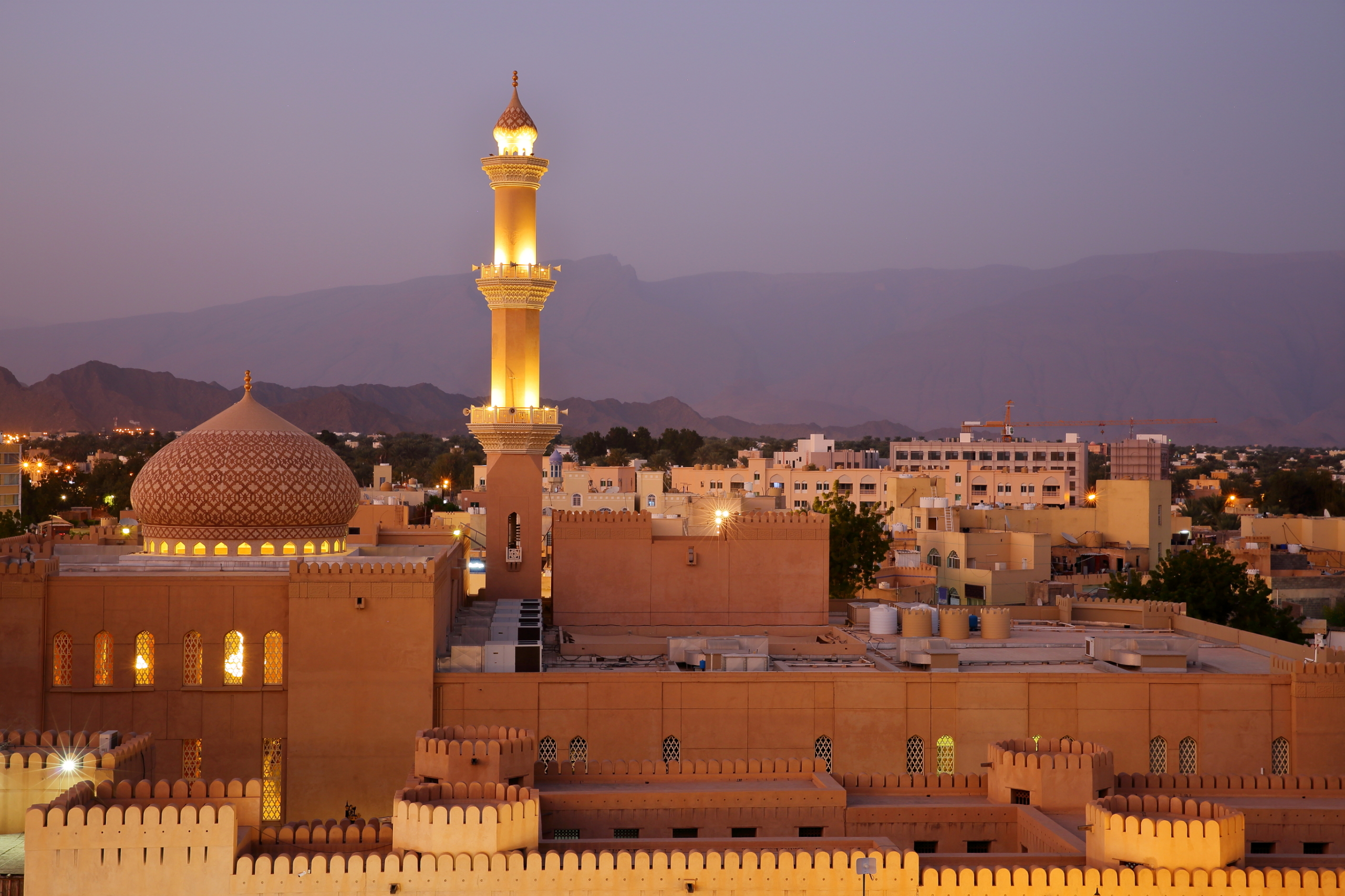
Exploring Nizwa Fort: A Journey Through Oman’s Rich History
Nizwa Fort stands as one of Oman’s most impressive architectural achievements through its 350-year history. The massive circular tower amazed me at first sight, and I couldn’t help but marvel at this remarkable structure that has watched centuries of Arabian history unfold beneath its walls.
The fort’s role extended beyond its military purpose. It was a vibrant center of governance, trade, and cultural life in ancient Oman. The fort’s prime location at the intersection of vital trade routes made it crucial to Nizwa’s defense system and administration.
This piece will guide you through every fascinating detail of this magnificent fortress. You’ll learn about its innovative defensive features and the daily routines within its walls. The architectural mastery behind its construction, its historical importance, and the best ways to experience its grandeur will unfold before you today.
The Architectural Marvel of Nizwa Fort
My first steps through Nizwa Fort’s entrance left me amazed by its massive scale. This architectural wonder stands as the Arabian Peninsula’s largest fort. The Ya’rubi dynasty built this masterpiece over 12 years in the mid-17th century, which shows the brilliance of Omani engineering.
Understanding the Circular Tower Design
The fort’s massive circular tower captured my attention. This defensive marvel reaches 34 meters high with a 45-meter diameter which dominates everything around it. The tower’s defensive features amazed me:
- 24 cannon openings that cover every angle
- Seven wells placed strategically for surviving sieges
- Multiple fake doors and hidden passages to confuse attackers
- Twisted staircases protected by thick wooden doors with metal spikes
Islamic Architectural Influences
The fort beautifully combines military strength with Islamic architectural grace. Traditional Omani craftsmanship shines through geometric patterns on the walls. The design follows Islamic principles, with graceful, curved walls that hide their defensive purpose.

Construction Techniques and Materials
The builder’s clever methods impressed me deeply. The foundations go 30 meters into the ground, making an unbreakable base. They used local stone and thick mud-brick walls that could withstand cannon fire, which shows their brilliant military planning.
The tower’s design proves medieval engineering excellence. The bottom half contains crushed stones, sand, and gravel that create a solid foundation. This structure has lasted through centuries of battles and harsh weather. The builders knew exactly what they were doing – they even built the fort above an underground stream that guaranteed water during long sieges.
The architect’s skill at combining defense with beauty caught my eye. Every element serves two purposes – from holes above doorways that once poured boiling oil to perfectly placed arrow slits. The sort of thing I love is how they created something both practical and beautiful.
Military Innovation and Defense Systems
The military genius behind this defensive stronghold amazed me as I walked along the fort’s battlements. Nizwa Fort’s strategic brilliance becomes clear when you see its sophisticated defense systems.
Strategic Location and Fortification Features
The fort’s location at the major trade route crossroads gave it perfect views of the surrounding area. I was particularly struck by the main tower’s elevated platform. Here I found 23 cannon positions that could cover all approaches in a complete circle. The walls I measured were several meters wide and could withstand heavy cannon fire.
Ancient Warfare Tactics and Technologies
The fort’s defensive systems showed me the fascinating rise of warfare technology. The fort’s key defensive breakthroughs included:
- Gun ports that narrow from inside to outside
- Complex zigzag stairways with multiple false doors
- Strategic “murder holes” to pour boiling liquids
- Honey trap systems to confuse trap invaders
- Circular shooting windows that allowed maximum mobility
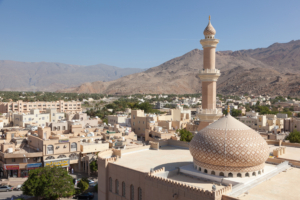
The Role of Natural Resources in Defense
The fort’s designers employed natural resources brilliantly for defense. They built the fortress above an underground stream, which meant a steady water supply during sieges. This smart engineering gave defenders access to fresh water – a vital advantage in a battle.
Local materials improved the fort’s defensive strength. The builders used local stone packed with rocks and earth to create incredibly strong walls. The storage rooms and ammunition chambers sat deep within these fortified walls, which kept vital supplies safe during attacks.
The military breakthroughs at Nizwa Fort went beyond simple force. They showed a deep understanding of defensive warfare that was way ahead of its time. Each element, from the shooting positions to the system of false doors and traps, played a strategic role in protecting this significant stronghold.
Life Within the Fort Walls
My first steps inside Nizwa Fort revealed a surprising contrast to its military exterior. The fort’s defensive features protected against outside threats, yet behind these walls lay a bustling community center that buzzed with daily life, governance, and spiritual activities.
Daily Activities and Social Structure
The rooms I explored painted a vivid picture of life inside the fort. The traditional kitchen showed centuries of use, and the coffee roasting room highlighted Omani culture’s emphasis on hospitality. The sort of thing I love was the clever date storage room. Here, dates weren’t just stored – their weight naturally squeezed out valuable syrup through channels built into the floor.
The fort’s living spaces included:
- A traditional hammam (bathhouse)
- Meeting halls for community gatherings
- Study rooms for scholars
- Specialized storage areas for provisions
- Secret escape passages for the ruling Imam
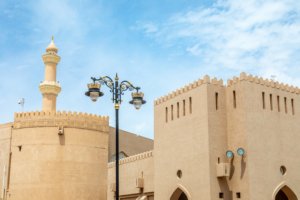
Administrative Functions and Governance
The administrative sections showed me that Nizwa Fort meant more than just defense – it was the region’s center of power. The fort served as the administrative seat of authority where presiding Imams and Walis managed both peaceful matters and conflicts.
The juridical chambers revealed the fort’s role in upholding law and order. These rooms witnessed vital decisions that shaped the region’s destiny. The Imam’s court acted as both a government center and justice hall.
Cultural and Religious Significance
The fort’s deep connection to Ibadi Islamic traditions left the deepest impression on me. The study halls showed how scholars debated religious texts and taught students here. The fort’s position as the administrative center of the Ibadi Imamate (1913-58) made it a vital site for religious governance.
Nizwa Fort’s spiritual importance reaches beyond its walls – it stands as proof of the city’s role in Islamic learning and culture. Each room carries the weight of history, where daily life followed the highest standards of morality and religious doctrine.
Preservation and Restoration
My recent visits to Nizwa Fort showed me the careful balance between protecting this historical treasure and making it work for modern tourism. Time has shaped the fort’s story through the most important preservation work that continues to define its future.
Conservation Challenges and Solutions
Local preservation experts told me about serious challenges the fort faced in the late 20th century. The biggest change came through an extensive renovation project between 1985 and 1995 that fixed critical structural problems. Water erosion threatened the fort’s foundations, which needed creative solutions to protect this ancient structure.
The preservation team worked on several key challenges:
- Structural reinforcement without compromising authenticity
- Water damage prevention and drainage improvements
- Protection of original architectural features
- Restoration of degraded defensive elements
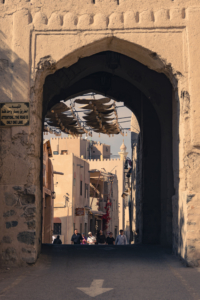
Modern Restoration Techniques
The team’s steadfast dedication to using traditional methods among modern conservation approaches impressed me deeply. They carefully picked local materials similar to those used centuries ago for restoration work. The preservation team managed to keep historical accuracy even in the smallest repairs.
Balancing Authenticity with Tourism
The fort’s story took a new turn in 2019 when Omran, Oman’s tourism development company, worked with Bawader International to manage operations. This partnership brought thoughtful improvements:
- Better visitor facilities that complement historical features
- Educational programs about fort conservation
- Guided tours highlighting preservation efforts
- Cultural demonstrations showcasing local heritage
The management team carefully follows the sustainable tourism approach based on UN World Tourism Organization guidelines. They’ve found the right balance between visitor access and conservation needs to protect the fort’s integrity from tourism pressure.
Community involvement makes this place special. Local residents act as cultural stewards and share their knowledge with visitors. This approach protects both the physical structure and the living heritage of Nizwa Fort. The management team works closely with local communities, who are the true guardians of this cultural treasure.
Experiencing Nizwa Fort Today
My recent trip to Nizwa Fort showed me how history and modern culture blend perfectly together. I’ve been to this magnificent structure several times and want to share what I learned to help you get the most from Oman’s most celebrated fortress.
Best Times to Visit and Photography Tips
My frequent visits taught me that the best time to visit Nizwa Fort is between October and April when the weather is mild. The fort welcomes visitors from 9 AM to 4 PM daily, but on Fridays it’s only open from 8 AM to 11 AM.
Here are some photography tips I picked up along the way:
- The golden hour light in early morning or late afternoon gives the best shots
- The circular tower looks stunning against the blue sky from the courtyard
- Early morning views of the Hajar Mountains from the tower’s top are breathtaking
- The fort’s archway creates natural frames for photos
- Remember to ask before taking pictures of locals or performers
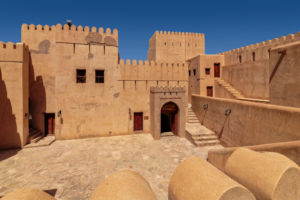
Cultural Demonstrations and Exhibits
My weekend visits let me see the amazing Razha folklore performances that happen on Friday mornings from 8:30 to 11:30. These shows bring ancient Nabati poetry to life with sword demonstrations and rhythmic music that fills the fort’s corridors.
The museum section really caught my attention with its well-planned exhibits. I spent time looking at:
- Traditional Omani weapons and khanjars (daggers)
- Ancient pottery and household items
- Historical documents and manuscripts
- Interactive displays about fort construction
- Traditional face masks (burqa) from different regions
Connecting with Local Heritage
Nizwa Fort stands out as a living cultural center. The local artisans who show off traditional crafts made my visits special. The fort sits next to Nizwa Souq, which creates a complete cultural experience. I liked starting my mornings at the fort before heading to the busy marketplace.
Interactive displays helped me understand both the building’s history and the region’s cultural development. The date storeroom fascinated me – it hasn’t changed since restoration and shows how people stored food in the past.
The cultural events and festivals that happen at the fort make visits even better. I tried traditional meat pastries and fresh bread at the local women’s food stations, which taught me more about Omani culture.
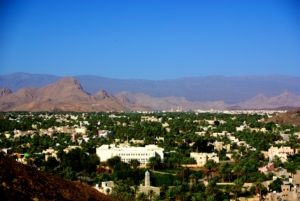
Conclusion
Nizwa Fort showcases Omani ingenuity by combining military excellence with cultural importance. This 350-year-old fortress amazed me with its impressive defensive features, rich historical legacy, and vibrant cultural demonstrations. The architectural brilliance still engages visitors today.
The fort’s preservation story touched me deeply. Traditional craftsmen work with modern conservation experts to bridge the past and future. This magnificent structure offers more than just historical significance because it perfectly balances authenticity with engaging visitor experiences.
Each visit reveals new aspects of Omani heritage. The fort’s circular tower demonstrates strategic genius, while its interior walls tell stories of daily life. Cultural demonstrations provide an exceptional glimpse into Oman’s rich history.
This fortress symbolizes Omani resilience and innovation actively. Thousands of visitors come yearly to experience its grandeur. My memories of Nizwa Fort remain vivid long after walking down its ancient steps. The fortress doesn’t just preserve history – it breathes life into it. Ready for your next adventure? Let’s make it real book now!
